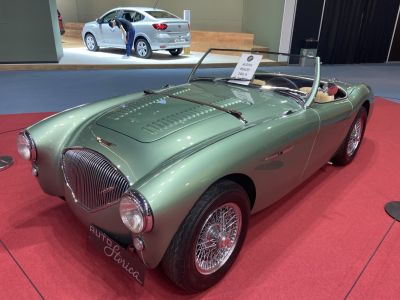 1953 AC Ace Bristol Dimensions, Size & Specs
1953 AC Ace Bristol Dimensions, Size & SpecsMeasurements of the 1953 AC Ace Bristol, engineered for optimal performance and comfort
| Dimensions | |
|---|---|
| Length: | 3780 mm148.8 in12.4 ft |
| Width: | 1510 mm59.4 in5.0 ft |
| Height: | 1220 mm48.0 in4.0 ft |
| Weight Specifications | |
| Curb Weight: | 815 kg1797 lbs |
The AC Ace Bristol is a classic British roadster produced between 1956 and 1960, representing an iconic era of lightweight sports cars. This generation of the AC Ace blends elegant styling with remarkably compact dimensions and a focus on driving agility. Measuring 3780 mm (148.8 inches) in length, 1510 mm (59.4 inches) in width, and standing just 1220 mm (48 inches) tall, the Ace Bristol offers a low and streamlined profile which contributes to its sporty aesthetic and lowered center of gravity. Weighing only 815 kg (1797 lbs), this roadster was notably lightweight, allowing for nimble handling and spirited performance from its modest yet effective powertrain options. The narrow width enhances its suitability for tight, twisty roads, while the relatively short length ensures a tight turning radius, ideal for enthusiastic driving enthusiasts. The AC Ace Bristol is often celebrated for its chassis engineering, which laid the groundwork for later legendary models such as the Shelby Cobra. Overall, the AC Ace Bristol stands as a quintessential mid-20th century sports car: compact, lightweight, and designed for drivers seeking a pure and engaging open-air motoring experience.
Discover the standout features that make the 1953 AC Ace Bristol a leader in its class
Have a question? Please check our knowledgebase first.
The AC Ace Bristol, produced between 1956 and 1960, is a classic British roadster known for its compact and sporty dimensions. It measures 3780 millimeters (148.8 inches) in length, 1510 millimeters (59.4 inches) in width, and stands 1220 millimeters (48 inches) tall. These relatively small and sleek dimensions contribute to its lightweight and agile driving characteristics, making it a nimble vehicle ideal for winding roads and spirited driving experiences.
The AC Ace Bristol has a curb weight of approximately 815 kilograms (1797 pounds). This lightweight construction was crucial in the car's performance profile, as it allows for quicker acceleration and more responsive handling. The lower mass makes it easier to maneuver, contributing to the car’s agility and sporty feel on the road. Additionally, the lightweight design helps improve fuel efficiency and braking performance, making the Ace Bristol a well-balanced classic sports roadster.
Yes, the AC Ace Bristol's compact dimensions make it suitable for most standard home garages. With a length of 3780 mm (about 12.4 feet), a width of 1510 mm (4.96 feet), and a height of 1220 mm (4 feet), it occupies less space compared to modern sports cars and sedans. This compact footprint means that owners usually won’t face difficulty fitting the Ace Bristol into a typical single-car garage, which generally ranges from approximately 2.4 to 3 meters wide (7.9 to 9.8 feet) and 5.4 to 6 meters long (17.7 to 19.7 feet).
At 1510 millimeters (59.4 inches) wide, the AC Ace Bristol is relatively narrow compared to many modern vehicles, but typical for sports cars of the 1950s. This narrow width reflects the design priorities of the era, emphasizing aerodynamics, lightweight construction, and simple, elegant proportions. Compared to similar roadsters of the 1950s, such as the early Jaguar XK120 or MG MGA, the Ace Bristol’s width is comparable, facilitating its nimble handling and market appeal as a small, sporty vehicle.
The AC Ace Bristol stands quite low at just 1220 millimeters (48 inches) in height. This low profile helps lower the center of gravity of the vehicle, enhancing stability and cornering abilities, which is crucial for sports cars designed for spirited driving. A low height also reduces aerodynamic drag, contributing to improved speed and fuel efficiency. Moreover, the sleek design adds to the classic sports car aesthetics that the Ace Bristol is celebrated for.
The AC Ace Bristol was developed as an evolution of the original AC Ace, incorporating enhancements in engine and chassis tuning thanks to the Bristol contributions. While both generations share very similar dimensions — the original Ace is also compact and lightweight — the Bristol version is typically slightly refined in terms of weight and performance balance. The Bristol engine brought more power, and the chassis tuning helped make the Ace Bristol slightly more agile and competitive in sports car terms. The dimensions (length around 3780 mm, width 1510 mm) remain close, so size differences are minimal but performance-wise the Bristol iteration is notably superior.
The AC Ace Bristol is smaller and lighter than many of its contemporaries. For example, the Jaguar XK140 is about 4480 mm (176 inches) in length and weighs around 1450 kg (3200 lbs), making it significantly larger and heavier than the Ace Bristol, which is 3780 mm (149 inches) long and weighs 815 kg (1797 lbs). The Triumph TR3 is somewhat closer in size but still larger — about 4030 mm (158.7 inches) long and weighing nearly 975 kg (2150 lbs). The AC Ace Bristol’s smaller dimensions and lighter weight give it an edge in agility and responsiveness compared to these larger sports cars, catering to driving enthusiasts who value nimble performance.
The AC Ace Bristol is a two-seat roadster, focusing on providing a driver-centric, sporty experience. Its compact design means interior space is optimized for just the driver and one passenger, with limited cargo room typical of sports cars from the 1950s. Compared to other roadsters from the era, the AC Ace Bristol's cabin was relatively roomy for a small sports car, but it prioritizes driving feel over passenger comfort or cargo capacity. Like many contemporaries, it was built for performance and style rather than practicality.
The compact size and lightweight design of the AC Ace Bristol positively influence its fuel efficiency and maintenance expenses. The lower weight requires less power to move, leading to relatively efficient fuel consumption compared to heavier cars of the same era. Moreover, smaller components and the simplicity of the design typically make repairs and maintenance more straightforward and less costly. However, as a classic British sports car, sourcing certain specialized parts might be pricier. Overall, its size contributes to manageable running costs for a vintage performance car.
The design and dimensions of the AC Ace Bristol clearly emphasize its role as a purist sports roadster from the 1950s. Its compact length of 3780 mm (148.8 inches), narrow width of 1510 mm (59.4 inches), and low height of 1220 mm (48 inches) give it a sleek, athletic silhouette. The light curb weight of 815 kg (1797 lbs) enhances its agility and performance on twisty roads and racetracks. The two-seat layout and minimalist interior focus on driver engagement rather than comfort or luxury. Overall, its dimensions and design capture the essence of mid-century British sports car engineering — lightweight, simple, and sporty.
Discover similar sized cars.

| Production: | 1953-1955 |
|---|---|
| Model Year: | 1953 |
| Length: | 3850 mm151.6 in |
| Width: | 1540 mm60.6 in |
| Height: | 1240 mm48.8 in |
